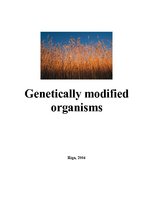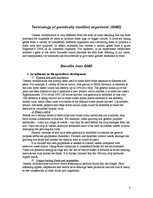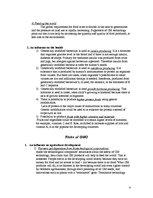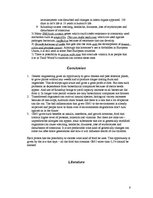| Nr. | Sadaļas nosaukums | Lpp. |
| Technology of GMO | 3 | |
| Benefits from GMO | 3 | |
| Risks of GMO | 4 | |
| Conclusion | 6 | |
| Literature | 7 |
Genetic modification is very different from the kind of cross breading that has been practised for hundreds of years to produce fatter pigs or bigger carrots. It involves taking genes from a variety of completely different organisms and combining them to produce a plant with new qualities. In effect, scientists can choose a certain genes from a given organism’s DNA of an unrelated organism. For instance, in an experiment researchers isolated a gene in the arctic flounder which prevents the fish from freezing in icy water, and transplanted it to tomatoes and strawberries to give them greater resistance to frost.
Benefits from GMO
1. An influence on the agriculture development
1)Disease and pest resistance
Genetic modification has already been used to make food crops resistant to diseases and pests. For example, a variety of maize (corn), first grown in North America, is resistant to the corn borer insect which can destroy up to 20% of a crop. The genetic make-up of the plant has been altered so that it produces a new protein which enables it to resist the insect. Approximately 25% of the 2000 US maize harvest was genetically modified in this way.
GM research is being carried out to make sweet potato plants resistant to the feathery mottle virus which often ruins two-thirds of the African sweet potato harvest. Cucumbers, lettuce, tomatoes, peppers and other horticultural crops could be modified to resist the destructive cucumber mosaic virus.
2) Weed control
Weeds are a serious threat to food crops and whilst many herbicides are available, they have certain limitations in practice. For example, when growing soy general purpose herbicides – witch kill range of weeds – can only be used before the crop emerges from the soil. Once the crop is visible, selective herbicides have to be used to combat weeds without damaging the growing soy crop.
Several varieties of soy have been genetically modified to tolerant the general propose herbicide glyphosate (Random). Farmers can therefore control weeds amongst the growing soy plans and choose the optimal time at which to spray.
It is claimed that less glyphosate is needed to control weeds compared with selective weed killers. Using fewer chemicals is considered better for the environment. …
Koncentrēti apskatīti galvenie ģenētiski modificēto organismu plusi un mīnusi.







